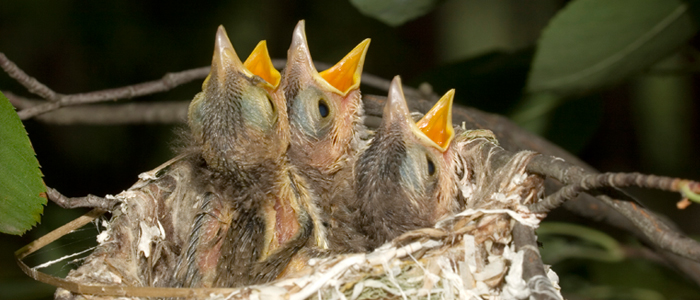
The Humane Society of Westchester is not licensed to handle wildlife rescues.
There are several wildlife rehabilitators in Westchester County that can assist and advise anyone encountering wildlife in need of rescue.
Animal Nation at 914-400-6014 is a referral hotline able to assist with most wildlife calls.
Common questions and answers about young wildlife:
Q. A very small baby bird has fallen from its nest in a tree in my backyard. I am afraid something might happen to it if I leave it there on the ground. Should I bring it into the house and feed it until it is able to fly?
A. No. The best thing to do is put the bird carefully back into the nest (or the nest itself back into the tree). But, do this ONLY IF YOU CAN DO IT SAFELY. Don't worry about getting your scent on the bird. Also, some birds that appear to have fallen from the nest are actually recently fledged and are learning to fly. They will not stay in the nest and the mother is in the area helping that fledgling. Move the fledgling away from roads and sidewalks and the mother will return and resume her care.
Q. A few minutes ago, I was walking through the woods behind our house and saw several young raccoons on the ground near a large hollow tree. I wonder if they fell out of the hole way up in the tree and the mother has abandoned them because she can't put them back in their nest. Should I bring them home and care for them?
A. No. Most likely, the young raccoons are merely exploring and their mother is nearby. They are probably old enough to be fully capable of climbing back up the tree to their den when they are ready to return. If they were too young to climb, the mother would carry them back. Also, you must remember that raccoons can carry rabies and can transmit it to humans, so do not attempt to handle them.
Q. There is a young blue jay in my backyard and it seems to be having difficulty flying. I am afraid that either my dog or cat will get it. Should I bring it inside and feed it until it is able to fly?
A. No. As a fledgling, it has enough feathers to leave the nest. This means it is old enough to learn to fly, which it will rapidly begin to do. Leave the bird alone, but you should keep your dog or cat in the house for a few hours so it won't disturb the bird.
Q. This morning I found an "abandoned" fawn near the edge of a field on my property. I brought the fawn into my house to save it, but I don't know how to care for it. What should I do?
A. In most cases, the fawn probably isn't abandoned. Immediately take the fawn back to the spot where you found it and leave it there. The mother should come back again looking for the fawn. Even one to two days after removal from the wild, fawns have been successfully reunited with their mothers by returning them to the place where they were found. When you picked up the fawn, the mother was probably not far away. Usually, young fawns are quite safe when left alone for the day by their mother.
Q. The cat just caught and killed a mother bird. The baby birds are now obviously orphaned. Shouldn't I take them to a wildlife rehabilitator?
A. Most songbird young are cared for by both parents. If one of the parent birds is killed, the surviving adult can successfully raise the chicks. Even if you think both parents are dead, call the rehabilitator for advice before taking any direct action with the young birds.
Q. A moment ago, I accidentally kicked open a nest of baby rabbits while walking in the thick grass at the far corner of my backyard. They seemed so helpless. I waited, but saw no sign of their mother. Should I rescue them?
A. They do not need to be rescued. The mother will not return as long as you remain at the nest. Just replace the top of the nest that you uncovered and leave. The mother will return and care for the young. Cottontail rabbits leave their young for many hours while eating, but return for a brief time to nurse the young. As with other young wildlife, it is best to LEAVE THEM ALONE!
Information From New York Department of Environmental Conservation